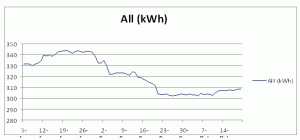The Raritan Blog
Home » Raritan Blog
Raritan IT publishes measured power savings by Power IQ
Allen Yang
October 22, 2010
In late August 2010, I wrote on this blog last time that Raritan IT will use Power IQ and PX to monitor the incremental power consumption of the Cisco UCS, while we gradually migrate some physical rack-mount physical servers as VM onto UCS blades. The following results reflect our P2V migration activities between 2010-08-05 and 2010-10-20. We have 2 UCS chassis that we call UCS1 and UCS2, and both of them are installed on our Cisco Rack 4. During the time period from 08/05 to 10/20, we had the following physical activities:
- 08/11: Turn on two blades on UCS for Engineering testing
- 08/15: Turn on 2nd 10Gib port on Fabric Interconnect
- 08/30: Remove 2 VMware ESX Servers (the 2 Dell PowerEdge 1950)
- 09/01: Turn 1 additional blade on UCS2 to measure its effect on power consumption
- 09/03: Remove SharePoint Test Server (a Dell PowerEdge 2850) and DNS2 (a 1U PC-server)
- 09/14: Migrate BES as a VM onto UCS blade (an HP Proliant DL140)
- 09/20: Migrate Exchange Server (a Dell PE1950) as a VM onto UCS blade; turn testing blade off
- 10/11: Turn one UCS blade on for Oracle JDE remote DR site
From Power IQ data reading we have the following observations:
- Each UCS blade we have consumes roughly 4.3 KWh per day. This is somewhat consistently demonstrated from measuring the total power consumption of the observed systems including the 2 UCS chassis and the non-UCS physical servers. On 08/11, the measurement was 334.6 KWh. On 08/12, 24-hours later after turning on 2 UCS blades, the measurement was 339.7KWh. Since then the UCS power consumption stayed at that level until the next even on 08/15. This 4.3KWh incremental power consumption per UCS blade per day was also consistently measured between 09/01 and 09/02 when IT turned on the 3rd blade on UCS2 to measure incremental power consumption.
- Migrating mildly loaded physical rack-mount servers as VMs onto the UCS blades typically doesn’t increase much power consumption. We Installed VMware ESX host on UCS and migrated two physical application servers onto UCS blade, and we couldn’t even find material difference before and after adding these 2 VMs onto UCS. But the power savings from decommissioning physical servers can be clearly seen. On 08/30, we removed 2 ESX host physical servers (Dell PowerEdge 1950), the total power consumption dropped by 6.55KWh a day. Then on 09/03, we removed another PowerEdge 2850 (a Sharepoint test Server) and a 1-U PC server (DNS); and we saw a drop of power consumption by 7.2KWh a day. Therefore, we see a clear power saving advantage from migrating physical servers into VMs.
- The new version of Power IQ is very helpful in data exporting and giving power consumption insights at various levels of details. We captured several diagrams from Power IQ to see the trend over time, then right from there we export the data into Excel spreadsheet, and we can examine the day by day details in there.
In summary, between 08/05 and 10/20, Raritan IT measured power saving of 20KWh a day with the activities of migrating 5 physical servers as VMs onto Cisco UCS blades and remove these physical servers from the racks. The daily power consumption of these observed systems combined dropped from slightly over 330KWh a day on 08/05 to slightly under 310 KWh a day on 10/20. The Power IQ trend diagram also portrays such gradual reduction, which very accurately reflects the activities conducted and the resulting effects on power consumption over the observed time period.
Power Consumption from Aug 5, 2010 to Oct 20, 2010
Raritan IT will continue its physical server migration activities in the next few months, there may be more interesting findings we can gather in the future; stay tuned.
(part of this blog entry is also posted in response to a comment for my late August blog post)
Subscribe
Upcoming Events
- AFCOM Data Center World
- April 15 – 18 • Walter E Washington Convention Center - Washington, DC
- National Association of Broadcasters
- April 13 – 17 • Las Vegas Convention Center - Las Vegas, NV
- Advancing Data Center Construction West 2024
- May 6 – 8 • Salt Lake City, UT
- Net Zero Data Center
- May 16 – 17 • Dallas, TX
- 7x24 Exchange Spring
- June 9th • JW Marriott Orlando Grande Lakes
Latest Raritan News
- Legrand Certifications and Process Controls Provide Confidence in Information Security for Network-Connected Devices in Data-Related Applications
- Posted on April 1, 2024
- Legrand Releases Version 4.0 of Raritan’s Industry-Leading Secure KVM Switches, Raising Bar for Secure Desktop Access
- Posted on July 31, 2023
- Legrand Revitalizes Data Center Sector with Two Revolutionary Intelligent Rack PDUs
- Posted on May 1, 2023
- Raritan Reveals The MasterConsole® Digital Dual KVM Switch
- Posted on February 18, 2021
- Legrand Data, Power and Control Division Announced as Finalist in Six Categories at DCS Awards 2020
- Posted on November 9, 2020
